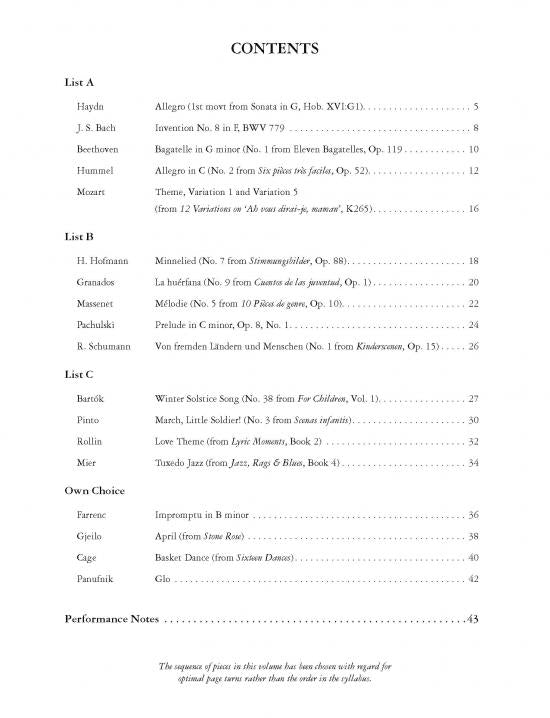ABRSM Grade 5 Piano Anthology for 2023-24
In stock and typically ships within 1 business day.
- Composers: Wolfgang Amadeus Mozart (1756-1791), Johann Sebastian Bach (1685-1750), Henryk Pachulski (1859-1921), Martha Mier (1936-), Andrzej Panufnik (1914-1991), Catherine Rollin, Ola Gjeilo (1978-), Johann Nepomuk Hummel (1778-1837), Robert Schumann (1810-1856), Ludwig van Beethoven (1770-1827), Louise Farrenc (1804-1875), John Cage (1912-1992), Octávio Pinto (1890-1950), Enrique Granados (1867-1916), Heinrich Hoffman, Joseph Haydn (1732-1809), Jules Massenet (1842-1912), Béla Bartók (1881-1945)
- Instrumentation (this edition): Piano
- Originally for: Cello, Piano
- ISMN:
- Size: 9.0 x 12.0 inches
Description
The Edition Peters Grade 5 Piano Anthology comprises 14 pieces from lists A, B and C of the Associated Board syllabus, together with 4 pieces suitable for the own-choice section of the Performance Exam. The anthology supports students preparing for either the Practical Exam or the Performance Exam. Those preparing for the Performance Exams are aided by Performance Notes by Norman Beedie (Lecturer in Classical Improvisation, Piano and Conducting at the Royal Conservatoire of Scotland), which give advice on technique and interpretation for each piece, and guidance on preparing an effective program. The pieces in this volume are drawn from the extensive range of piano music in the Edition Peters catalogue — one of the widest available. The own-choice pieces provide a valuable selection of fascinating repertoire suitable for the Performance Exam.
Works:
- Allegro, 1st movement from J. Haydn: Piano Sonata in G Major, Hob. XVI:G1
- Bach: Invention No. 8 in F Major, BWV 779
- No. 1 in G Minor from Beethoven: 11 Bagatelles, Op. 119
- Allegro in C, No. 2 from Hummel: 6 pièces très faciles, Op. 52
- Theme; Variations 1 & 5 from Mozart: 12 Variations on "Ah, vous dirai-je Maman", K. 265 (300e)
- Hoffman: No. 7 from Stimmungsbilder, Op. 88
- No. 9 from Granados: Cuentos de la juventud (Album for the Young), Op. 1
- No. 5 from Massenet: Mélodie (Elegy from The Erynnies), Op. 10
- No. 1 from Pachulski: 6 Preludes, Op. 8
- No. 1 from R. Schumann: Kinderszenen (Scenes from Childhood), Op. 15
- Winter Solstice Song from Bartók: For Children, Sz. 42, BB 53
- March, Little Soldier from Pinto: Scenas Infantis (for solo piano)
- Rollin: Love Theme from Lyric Moments
- Mier: Tuxedo Jazz
- Farrenc: Impromptu in B Minor
- Gjeilo: April
- Basket Dance from Cage: Sixteen Dances
- Panufnik: Glo
Publishers use a lot of words to describe what they sell, and we know it can be confusing. We've tried to be as clear as possible to make sure you get exactly what you are looking for. Below are descriptions of the terms that we use to describe the various formats that music often comes in.
Choral Score
A score for vocalists that only contains the vocal lines. The instrumental parts are not there for reference. Generally, cheaper than a vocal score and requires multiple copies for purchase.
Facsimile
Reproductions of the original hand-written scores from the composer.
Full Score
For ensemble music, this indicates that the edition contains all parts on a single system (there are not separate parts for each player). In larger ensembles, this is for the conductor.
Hardcover
Hardbound. Generally either linen-covered or half-leather.
Orchestral Parts
Similar to a wind set, this is a collection of parts. In the case of strings, the numbers listed are the number of copies included, though generally these are available individually (often with minimum quantities required).
Paperback
When publishers offer multiple bindings (e.g. hardcover) or study scores, this is the "standard" version. If you're planning to play the music, this is probably what you want.
Performance / Playing Score
A score of the music containing all parts on one system, intended for players to share. There are not separate parts for each player.
Set of Parts
For ensemble music, this indicates that there are separate individual parts for each player.
Solo Part with Piano Reduction
For solo pieces with orchestra, this is a version that contains a piano reduction of the orchestra parts. For piano pieces, two copies are typically needed for performance.
Study Score
A small (think choral size) copy of the complete score meant for studying, and not playing. They make great add-ons when learning concertos and small chamber works.
Vocal Score
A score prepared for vocalists that includes the piano/organ part or a reduction of the instrumental parts.
Wind Set
For orchestral music, this is a collection of wind and percussion parts. The specific quantities of each instrument are notated.
With Audio
In addition to the printed music, the edition contains recordings of the pieces. This may be an included CD, or access to files on the internet.
With / Without Fingering (Markings)
Some publishers prepare two copies - a pure Urtext edition that includes no fingering (or bowing) suggestions and a lightly edited version that includes a minimal number of editorial markings.





